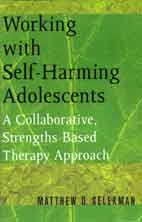Working with Self-Harming Adolescents: A Collaborative, Strengths-Based Therapy Approach

Book Details
- Publisher : W.W.Norton
- Published : 2006
- Cover : Paperback
- Category :
Child and Adolescent Studies - Category 2 :
Attachment Theory - Catalogue No : 23530
- ISBN 13 : 9780393704990
- ISBN 10 : 0393704998
Customer Reviews
Our customers have given this title an average rating of 2 out of 5 from 1 review(s), add your own review for this title.
Richard Skaff on 01/03/2007




 (2 out of 5)
(2 out of 5)
Selekmans book is a decent resource for the novice clinician who decides to work with the self-harming adolescent population. While Selekmans long term experience can provide us with lots of interesting hypotheses on what works and what doesn't in this field, it might also get us immersed in a sea of conjecture. Psychology and psychiatry are after all based on speculation! While it might be fun to share success stories, Selekmans case studies presented a great illustration of his skills and ability, which might also greatly benefit his private practice. The reality is that what works for one individual might not work for another.
This book might be helpful for some parents and for uninformed self-absorbed therapists that allow their own issues to interfere with the progress of their clients (as Selekman implied in one of his chapters). His arguments could sound very convincing at times, especially when he has backed them up with some ancient studies (i.e. from 1975, 1981, p.3, 1989, p.153 etc.) and few recent ones. Interestingly, the studies were well positioned to fit into his theory of practice and/or style of treatment. His book will provide the reader with some helpful insights and tips as well as some creative interventions that might work with the self-harming adolescent.
However, Selekman has failed to address the key issue of implementation of his interventions in an outpatient setting. Implementation could face many major obstacles that can render treatment futile. Implementation is extremely difficult in an outpatient setting due to the patients lack of compliance, lack of ability, and unchanged environmental factors. Consistent implementation of interventions, in addition to compliance constitutes the core element for a successful treatment outcome. Finally, this book does not offer anything new; however, it will provide the reader with a body of literature that delves into the reasons behind self-injurious behavior.

